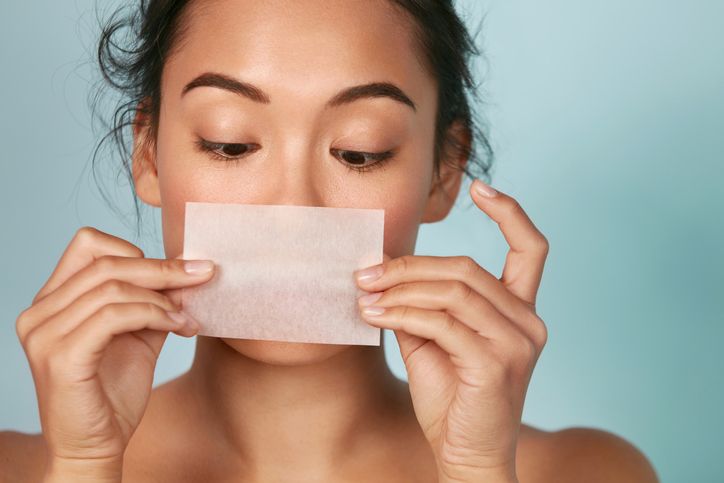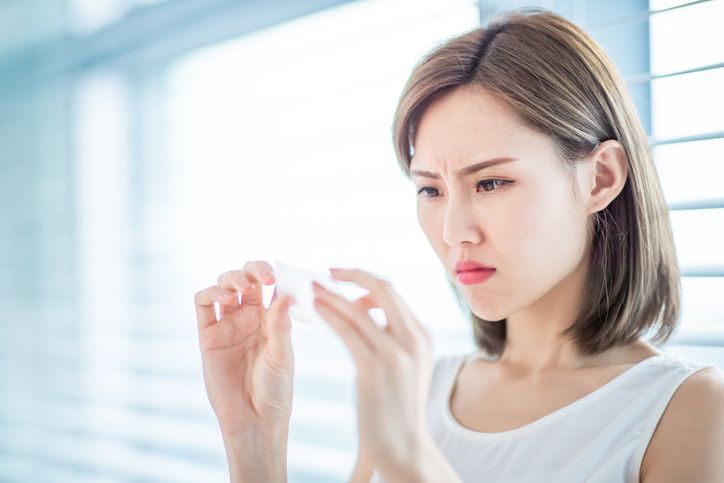- Home
- Trend
- Weight Loss Strategies
- Acne Tips
- Hair Health Information
- Blemish Removal Tips
- Acne Scar Removal Tips
- Muscle Building Techniques
- Intimate Care Tips
- Postpartum Intimate Care
- Eye Bags Wiki
- Tips for Face Slimming
- Secret of Permanent Hair Removal
- Breast Enlargement Tips
- Cure to Snoring
- Marionette Lines
- Skin-Tightening Secrets
Most people have probably used blotting paper at some point, and some can’t live without it. Especially in hot weather when our skin gets oilier, just a few dabs with a thin blotting sheet can help manage facial oil quickly without ruining your makeup. For those with oily skin, blotting paper helps remove excess sebum, reducing the chances of blackheads, clogged pores, and acne.
But there’s also a widespread belief that using blotting paper too often can make your skin even oilier over time. Is that true? Could blotting paper actually be bad for your skin? In this article, we investigate the science behind blotting paper, its different types, and how to use it properly.
Why Can Blotting Paper Absorb Facial Oil?

Blotting paper (also known as oil-control paper) may look like just another piece of paper, but it’s much more than that. Originally, this type of paper was used to separate sheets of gold leaf. People later discovered that its capillary structure made it highly effective at absorbing sebum from the skin. Blotting paper works because its molecular structure binds easily with oil molecules, allowing it to quickly lift away excess oil and refresh the skin.
The 5 Most Common Types of Blotting Paper: Which One Absorbs Oil Best?

You may have noticed that not all blotting papers feel the same. That’s because they come in different materials and types, each with varying properties and suitability for different skin types. Here are the five most common types:
Type 1: Blue Film Blotting Paper
The most popular and widely used type. It has a plastic-like texture that’s strong and tear-resistant. Its oil-absorbing power is excellent, making it ideal for oily skin. However, because it absorbs so effectively, frequent use may dry out your skin. Clean & Clear’s oil control film is a typical example of this type.
Type 2: Linen Fiber Blotting Paper
This type contains plant fibers, giving it a rougher texture. It's thinner and less absorbent than blue film types, making it better suited for dry or normal skin. Be gentle when using it, as its roughness could irritate or damage delicate skin.
Type 3: Rice Paper Blotting Paper
Highly popular in Japan, rice paper blotting sheets can often be reused, earning favor among eco-conscious consumers. They absorb oil well without lifting makeup — ideal for people who wear foundation regularly.
Type 4: Powdered Blotting Paper
These sheets are infused with cosmetic powder, so they absorb oil while touching up your makeup. However, the mixture of powder and sebum may clog pores, so this type should be used sparingly.
Type 5: Gold Leaf Blotting Paper
Infused with gold particles, this type not only absorbs oil but also has antibacterial and anti-inflammatory properties, making it great for sensitive skin. It’s dense and highly absorbent, making it a good option for oily skin as well.
免費體驗
Acne Treatment
1 Minute Self-Registration
Date should not be before minimal date
How to Choose the Right Blotting Paper for Your Skin
Still unsure after reading the above? Here are some key factors to consider:
i. Your Skin Type
As with any skincare product, you need to choose based on your own skin type — don’t just follow trends. What works for others may not suit you. For example, oily skin needs stronger oil control, while dry or combination skin may benefit from milder options like linen fiber blotting paper.
Also, even people with dry or normal skin may need blotting paper during hot weather, especially in oily-prone areas like the T-zone and around the nose.
ii. Size of the Blotting Paper
Smaller sheets are easier to carry around and ideal for light oiliness. However, if your skin produces a lot of oil, small sheets might not be sufficient for full coverage.
iii. Additional Features
Some blotting papers come with added benefits, like powdered sheets that also touch up makeup. While these features are nice, don’t let them distract from the main purpose: absorbing oil. Always prioritize compatibility with your skin.
iv. Fragrance and Additives
Some blotting papers are scented, but added fragrance can irritate the skin — especially for those with sensitive skin. Always check for potential allergens before use.
How to Use Blotting Paper Properly
Many people use blotting paper incorrectly — rubbing or dragging it across the skin like a towel. While this may absorb oil, it can also irritate the skin and strip it excessively, potentially triggering breakouts.
Here’s how to do it right:
i. Use No More Than Twice a Day
Even if your skin is oily, avoid overusing blotting paper. Sebum acts as a natural barrier protecting the skin from pollutants and dehydration. Removing too much oil too often leaves the skin vulnerable and may cause it to overcompensate by producing even more oil — a vicious cycle. Stick to twice a day at most, spaced about 6–7 hours apart.
ii. Use a Gentle Pressing Motion
Never rub or drag the sheet across your face. Instead, use your index and ring fingers to gently press the paper onto oily areas. Avoid excessive pressure to prevent damage or pushing dirt back into the pores. Afterward, consider using a hydrating mist to rebalance moisture levels.
iii. Use Only on Oily Areas
Don’t blot your whole face indiscriminately. Focus on the oilier zones like the forehead, nose, and chin. Blotting dry areas like the cheeks can cause dehydration and irritation.
iv. Pay Attention to Which Side You Use
Some blotting papers have a distinct front and back — one side may feel rougher than the other. Always use the rougher side to blot oil. If both sides feel the same, then either side will work.
Editor’s Test: Perfect Medical’s Acne Treatment — A More Effective Fix Than Blotting Paper?
I’ve had oily skin for as long as I can remember, and I’ve always struggled with acne caused by excess oil — a frustrating cycle. Recently, I decided enough was enough and tried out the Perfect Medical Acne Treatment that I saw many people recommend online.
At the clinic, the therapist started with a detailed skin analysis, then used a proprietary device to gently massage my face. As the session progressed, I could feel impurities being drawn out from deep within my pores. At the end, I was shocked — a full container of cloudy, yellowish gunk had been extracted!
But that wasn’t all — the therapist then applied their exclusive acne-fighting serum, using a special device to help it penetrate deep into the skin.
Even though it was just a free trial session, the results were surprising. For the whole following week, my skin looked visibly clearer and more radiant. My face stayed oil-free all day — even after washing in the morning, I stayed fresh until night. The small pimples on my chin even disappeared!
Just one session gave me these results — I’m genuinely impressed. If you also have oily skin and feel like you’ve tried everything without success, I highly recommend giving Perfect Medical a shot. You might be pleasantly surprised too!
Free Trial Available: Perfect Medical Acne Treatment免費體驗
Acne Treatment
1 Minute Self-Registration
Date should not be before minimal date
FAQ

What is the principle behind oil blotting paper?
It’s understood that oil blotting paper was originally just regular Japanese washi paper used to sandwich gold leaf. Later on, people discovered that the capillary structure within this type of washi paper could effectively absorb oil from human skin, which led to the development of oil blotting paper. Reportedly, the reason oil blotting paper can absorb oil is because its molecular structure easily binds with oil molecules, allowing it to quickly lift excess sebum from the skin and restore a refreshed appearance.
Does using oil blotting paper harm the skin?
Oil blotting paper can remove excess sebum from the skin, keeping it dry and helping to prevent the formation of blackheads, whiteheads, and acne. However, excessive use of blotting paper can strip the skin of its necessary sebum, leading to excessive dryness. This can create a vicious cycle, causing the skin to produce even more oil. Furthermore, overusing blotting paper can leave the skin directly exposed to the air, making it easier for microorganisms, dust, bacteria, and other impurities to invade the skin, potentially leading to various skin problems.
How should oil blotting paper be used?
Many people are accustomed to rubbing and pulling their skin with blotting paper, but this can easily damage the skin. The correct way to use blotting paper is to hold it between your index and ring fingers, and gently press it onto your face to absorb excess oil. After using blotting paper, you can follow up with a hydrating mist to replenish moisture and help maintain the skin’s oil-water balance.
How many times can you use oil blotting paper in a day?
To avoid excessive dryness, the frequency of using blotting paper should be carefully controlled. It’s recommended to use blotting paper no more than twice a day. Additionally, there should be a gap of about six to seven hours between each use to prevent the skin from drying out too much.
Will using oil blotting paper ruin makeup?
If used correctly and gently, oil blotting paper will not damage or disrupt your makeup. In fact, because it removes excess sebum from the skin, blotting paper can actually help prevent makeup from wearing off.









